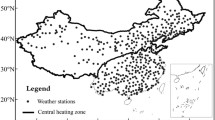Abstract
In recent decades, it presents a more obvious temperature rise in urban area along with the global warming. City is generally the center of human society, so the study on urban temperature variation will be helpful to our city development planning that is to reduce urban warming. The study is also helpful to a more comprehensive understanding of the causes of climate warming, which could provide a theoretical support to the government to make more reasonable international energy policies. Local temperature rise has different mechanisms with the global warming: large quantities of artificial heat release from the energy consumption will stay in urban areas for a period of time, which will inevitably influence the short-term trend of the local temperature change. Based on that view, a structural thermodynamic model was established in this paper to investigate the effect of the artificial heat release on the urban local temperatures. In the model, the city environment was divided into Human, Local, Outer three blocks, and then the heat and temperatures of the blocks were analyzed based on the laws of thermodynamics. After that, the effect of artificial heat release in Human block on the local temperatures was clarified. The model shows that the artificial heat release has an approximately linearly promoting effect on the local temperature rise, and the more the heat release is, the stronger the effect is. In addition, a validation of that model was carried out based on some national statistical data. The data of temperatures and artificial heat release of some provincial capitals of China were analyzed with linear regression extrapolation method and Pearson correlation statistical method. The results show that in most capital cities, the temperature variations basically depend on the artificial heat release in a linear relationship, which usually becomes more apparent with the increase of the artificial heat release in both spatial and temporal dimensions. The conclusions of the statistics have good conformity with the model and the rationality of the model is verified.
Similar content being viewed by others
References
Houghton J T, Ding Y, Griggs D J, et al. Climate Change 2001: The Scientific Basis. Cambridge: Cambridge University Press, 2001
Crowley T J. Causes of climate change over the past 1000 years. Science, 2000, 289(5477): 270–277
Broecker W S. Global warming: to move or to wait? Chinese Sci Bull, 2006, 51(13): 1489–1499
Gu Z W. The effects of climate warming and human turbulence on the permafrost in the northward slope—take a sample from Amur area (in Chinese). Acta Geogr Sin, 1994, 49(2): 182–187
Huang Q Z, Shao X X. The influence of climate warming on infec tion (in Chinese). Chinese J Pest Contl, 2000, 16(2): 110–112
Lai Y M. The cooling effect of the qingzang railway embankment under the climate warming background (in Chinese). Chinese Sci Bull, 2003, 48(3): 292–297
Xu X F, Tian H Q, Wan S Q. Climate warming inpacts on carbon cycling in terrestrial ecosystems (in Chinese). J Plant Ecol, 2007, 31(2): 175–188
Zheng Y F, Niu L Y. Climatic warming and its impact on Chinese agriculture (in Chinese). J Anhui Agri Sci, 2008, 36(10): 4193–4195
Petit J R, Jouzel J, Raynaud D, et al. Climate and atmospheric history of the past 420000 years from the Vostok ice core, Antarctica. Nature, 1999, 399(6735): 429–436
Fang J Y. Global warming and carbon emissions (in Chinese). The Conference Report on the 15th Academician Meeting of Chinese Academy of Sciences, Beijing, 2010
Li H B. Quantitative analyses of global warming and prediction for global mean temperature change (in Chinese). Dissertation for Master Degree. Hangzhou: Zhejiang University, 2007
Niu Q, Lin F, Li L, et al. Comparison study between the energy consumption of provinces of China and the temperature variety of their capitals (in Chinese). China Energy Forum. Beijing: Chemical Industry Press, 2010
CICERO Report 2000: 1—Climate change. Scientific background and process. 2002. 23
Qian W H, Lu B, Zhu C W. How would global-mean temperature change in the 21st century? (in Chinese). Chinese Sci Bull, 2010, 55(16): 1532–1537
Wang X R, Wang S G. Practical Multivariate Statistical Analysis (in Chinese). Shanghai: Shanghai Science and Technology Press, 1990
Liu L X, Zhou L X, Zhang X C, et al. Characteristics of CO2 concentration in atmosphere of China’s four state based stations (in Chinese). Sci China Ser D-Earth Sci, 2009, 39(2): 222–228
Author information
Authors and Affiliations
Corresponding author
Rights and permissions
About this article
Cite this article
Niu, Q., Nie, C., Lin, F. et al. Model study of relationship between local temperature and artificial heat release. Sci. China Technol. Sci. 55, 821–830 (2012). https://doi.org/10.1007/s11431-011-4669-5
Received:
Accepted:
Published:
Issue Date:
DOI: https://doi.org/10.1007/s11431-011-4669-5




